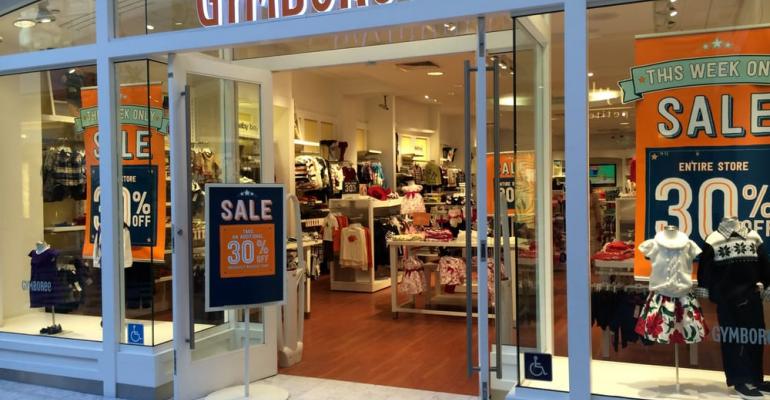The retail industry’s children’s apparel segment took a turn for the worse last week, as The Gymboree Corp. filed for bankruptcy and Ascena Retail Group, parent of tween brand Justice, said it would close stores across its portfolio.
San Francisco-based Gymboree is aiming to reduce its debt load t by more than $900 million, and in a statement said it plans to close more than 350 stores as a result of its restructuring (out of a total of 1,281). Ascena is expected to close between 650 and 667 stores across its 4,878-unit portfolio. It is unclear how many Justice stores will be affected by the move.
Retail real estate professionals often have starkly different views on the current state of malls and shopping centers: Is e-commerce killing traditional retail and threatening shopping centers or not? The answer might not be a simple ‘yes’ or ‘no,’ but Ascena executives minced no words in attributing the loss to fewer brick-and-mortar visits.
In an overview of results from its third quarter, which ended on April 29, Mahwah, N.J.-based Ascena noted that total company net sales had dropped to $1.5 billion, an 8.0 percent decrease from the previous quarter. Store traffic was down to low double digits across all of its major business segments, including premium fashion, value fashion and plus-size fashion, according to a company statement.
Tween-centered Justice is one of several apparel brands in its stable. The brand was once a leader in its segment, a place where every tween girl in America thought she needed to shop, says Jan Kniffen, CEO of J. Rogers Kniffen Worldwide Enterprises, an equity research and financial management consulting firm specializing in retail.
In recent years, however, it has faced competition from Carter’s and The Children’s Place, which moved its stores out of malls and improved fashion, pricing and supply chain management. Discount players like Target and H&M have either improved existing or launched new tween apparel departments as well, taken a huge bite out of Justice’s once- huge slice of the tween pie. Another core issue that all children’s and tween apparel retailers must grapple with is pricing pressure, Kniffen notes.
“It is a tough business. People don’t like to pay up for children’s clothes,” he says. “They don’t last long enough. Children grow out of them. They wreck them. Price has always been extraordinarily important.”
So important, that the average price of an outfit from a children’s or tween apparel retailer has dropped by 40 percent in the last 10 years. Ascena has tried to ease this pricing pressure—across all of its brands—by assembling different retail brands and reducing back-shop costs, Kniffen notes.
“It is a great strategy, but the bad news is the brands haven’t done that well. The reasons are pretty much the same.”
For mall landlords, these latest developments continue a stream of gloomy news that has flowed through the sector all year. The industry has seen about 250 percent more store closures year-to-date than it had for all of 2016, says Kniffen.
Green Street Advisors, a Newport Beach, Calif.-based research firm, reduced its forecasts for non-anchor retail occupancy for 2017 and 2018 by 60 basis points, according to its latest mall sector update. The effect on malls will depend on how strong they were to begin with, according to Green Street analysts.
As expected, the closings will hit lower quality malls hard by adding yet more supply to the already over-saturated market. The firm expects fundamentals at those centers to continue deteriorating. Market rent growth at highly productive class-A malls, on the other hand, should outpace retail sales, according to Green Street.
Given the current retail sector conditions, Green Street Advisors has reduced its same-property net operating income (NOI) expectations for the next two and a half years. Its expectations are as follows:
In 2017, a 2.6 percent same-property NOI is expected, down from 3.3 percent
In 2018, a 2.5 percent same-property NOI is expected, down from 3.2 percent
In 2019, a 2.8 percent same-property NOI is expected, down from 2.9 percent
While Green Streets’ research indicates that losses in same-property NOI might slow down by 2019, retail experts expect the mall sector to continue to feel the effects of changes in retail demand beyond that.
Kniffen predicts that about 400 malls will close by 2030. For the remaining malls, whether they are class-B or class-A centers, a much different future awaits.

